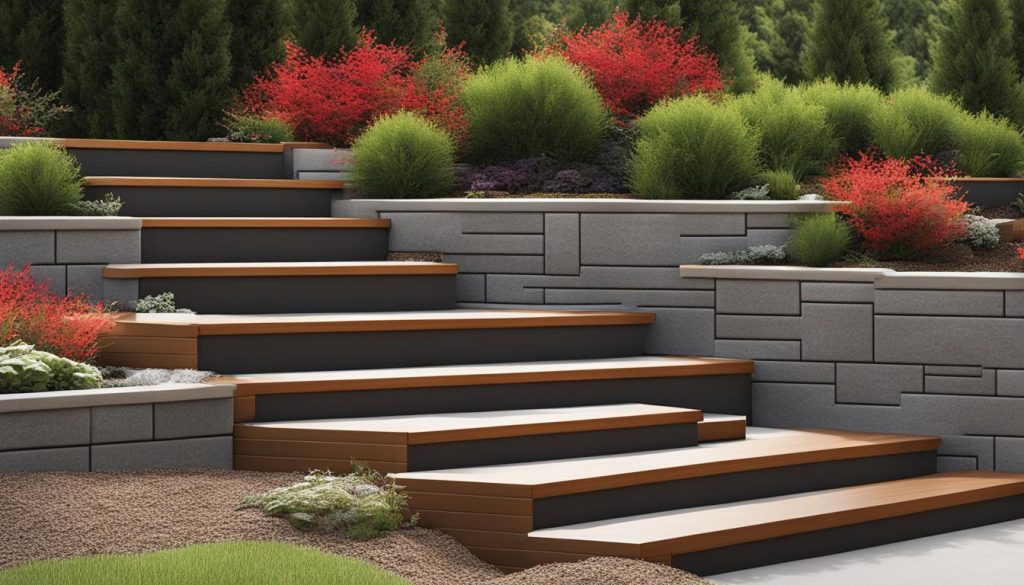Welcome to our comprehensive guide to retaining wall construction! If you’re considering building a retaining wall, it’s important to understand the process and have the right tools and techniques to ensure success. In this section, we will simplify the construction process by providing expert advice and tips on everything you need to know about building a retaining wall, from planning and design to choosing materials, construction techniques, and maintenance.
At Retaining Wall Repair, we have years of experience in constructing durable and long-lasting retaining walls for residential and commercial properties in Canada. We believe that with the right knowledge and guidance, anyone can build a retaining wall that is structurally sound, safe, and aesthetically pleasing. So, whether you’re a first-time DIYer or a professional builder, we’ve got you covered.
Key Takeaways:
- Retaining wall construction requires proper planning, design, and site preparation.
- Choosing the right materials is essential for the longevity and durability of your retaining wall.
- Construction techniques and tools are crucial for building a structurally sound and aesthetically pleasing retaining wall.
- Maintenance is important to prevent issues such as soil erosion and structural damage.
- Hiring a professional retaining wall contractor can save time, effort, and potential mistakes.
Understanding Retaining Walls
At Retaining Wall Repair, we believe that before you start building a retaining wall, you should have a thorough understanding of what they are and their purpose. Retaining walls are structures that are designed to hold back soil and prevent erosion. They are commonly used in landscaping to create level surfaces and to provide support for steep slopes.
Retaining walls can be made from a variety of materials, including concrete blocks, natural stone, timber, and gabions. The type of material you choose will depend on factors such as the height and length of the wall, the soil conditions, and your personal preferences.
One of the key benefits of retaining walls is their ability to prevent slope failure. Slope failure can occur when there is too much weight or pressure on a hillside, causing the soil to slide or collapse. Retaining walls help to distribute the weight evenly and prevent slope failure from occurring.
Retaining walls can also be used to create level surfaces, such as terraces or patios. This is particularly useful in sloping landscapes where it may be difficult to create a flat surface for outdoor activities.
Significance of Retaining Walls
Retaining walls are significant structures that provide a range of benefits, such as:
- Preventing soil erosion and slope failure
- Creating level surfaces for outdoor activities
- Enhancing curb appeal and adding value to your property
- Managing water runoff and preventing flooding
- Providing support for elevated gardens and planter boxes
Understanding the significance of retaining walls and their purpose is essential for successful construction. At Retaining Wall Repair, we are here to help you every step of the way.
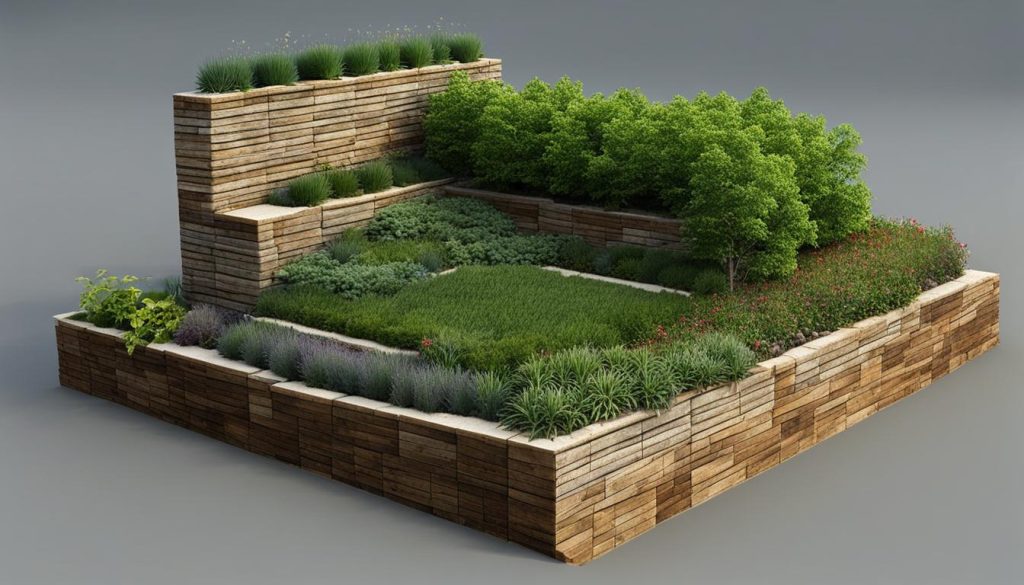
Whether you’re a homeowner, designer, or contractor, we offer professional retaining wall construction services that simplify the process and ensure a structurally sound and aesthetically pleasing end result. Contact us today to learn more!
Planning and Designing Your Retaining Wall
Planning and designing your retaining wall is a crucial step that requires careful consideration of various factors. Before starting your project, it’s essential to evaluate the site and identify potential challenges to ensure that your retaining wall is structurally sound and meets all legal requirements.
Here are some important factors to consider when planning and designing your retaining wall:
Height and Length
The height and length of your retaining wall will depend on the slope of the land, the soil type, and the purpose of the wall. For example, a residential retaining wall may be only a few feet high, while a commercial or industrial wall may require a higher elevation to support the weight of a building or prevent soil erosion.
When designing your wall, it’s important to follow local building codes and regulations to ensure that your wall is safe, structurally sound, and meets all legal requirements.
Soil Conditions
The type of soil on your site will greatly influence the design and construction of your retaining wall. The soil must be properly compacted, graded, and leveled to ensure a stable foundation and prevent soil erosion.
If the soil is unstable and prone to erosion, you may need to install a drainage system to prevent water buildup behind the wall, which could cause the wall to fail.
Drainage
Proper drainage is essential for retaining wall construction. Without it, water can build up behind the wall, causing soil erosion and compromising the integrity of the structure. Installing a drainage system can help prevent water buildup and ensure the longevity of your retaining wall.
Permits
Before starting your project, it’s essential to obtain any necessary permits and approvals from local authorities. Failure to do so can result in legal and financial consequences, as well as delays in your project’s completion.
Planning and designing your retaining wall requires careful consideration of various factors to ensure a successful outcome. We recommend consulting with a professional retaining wall contractor to ensure your wall is structurally sound and meets all legal requirements.
Choosing the Right Materials
When it comes to selecting materials for your retaining wall, you have several options available, each with its own advantages and disadvantages. It’s essential to choose the right materials that can withstand the pressure of the soil, provide drainage, and resist erosion. Keep in mind that the materials you choose can affect the overall appearance and durability of your retaining wall.
Concrete Blocks
Concrete blocks are a popular option for retaining wall construction because they are relatively affordable and easy to install. They are available in a range of sizes, shapes, and textures to suit different styles and preferences. Concrete blocks are also resistant to weather damage and require minimal maintenance over time. However, they are not the most aesthetically appealing option, and their weight can make them challenging to handle during installation.
Natural Stone
If you’re looking for a more natural and visually appealing option, natural stone might be the right choice for you. It can add a rustic and authentic look to your retaining wall and blend in with the natural environment. There are several types of natural stone available, including limestone, sandstone, and granite, and each has its own unique qualities. Natural stone is durable and long-lasting, but it can be more expensive than other options, and its weight can complicate installation.
Timber
Timber can add a charming and warm appearance to your retaining wall and is a popular choice for residential landscaping. It is also relatively inexpensive and easy to handle during installation. However, timber requires regular maintenance to prevent rot, insect infestation, and weather damage. It is also not as long-lasting as other materials, with an average lifespan of about 10-20 years.
Gabions
Gabions are wire mesh containers filled with stones or other materials and are an eco-friendly option for retaining wall construction. They provide excellent drainage and can withstand extreme weather conditions. Gabions can also blend in with the natural environment and offer a unique aesthetic appeal. However, they can be more expensive than other options and require professional installation to ensure structural integrity.
Choosing the right material for your retaining wall requires careful consideration of your budget, preferred style, and functional requirements. It’s always advisable to consult with a professional contractor like us at Retaining Wall Repair to help you make the best decision that suits your needs.
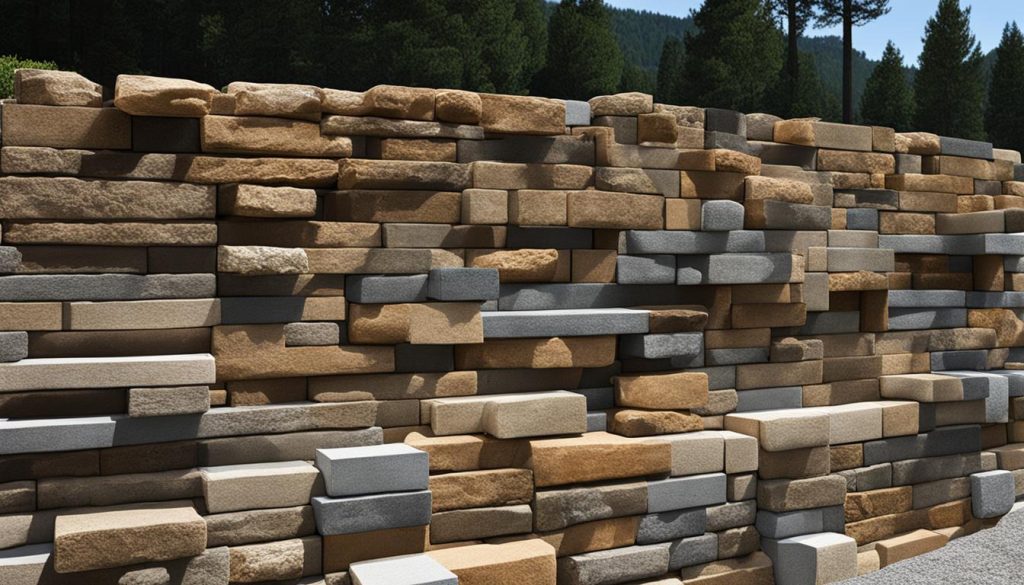
Preparing the Site
Before starting the retaining wall construction process, it’s crucial to properly prepare the site. This involves clearing the vegetation, leveling the ground, and assessing the soil conditions. Failure to prepare the site adequately can lead to a weak foundation and potential wall failure.
First, remove any vegetation, rocks, and debris from the area where the wall will be constructed. This includes grass, shrubs, and trees with roots that may interfere with the foundation. Ensure that the area is clear of any objects that may impede the construction process.
Next, level the ground where the wall will be constructed. This is essential to provide a solid foundation and ensure the level of the wall. Use a line level to ensure that the ground is level, and make any necessary adjustments before proceeding.
The soil conditions are another critical factor to consider when preparing the site. The soil should be tested for stability, drainage, and compaction. Depending on the results, additional measures may need to be taken to ensure the stability of the wall. For example, if the soil is unstable, soil stabilization may be required with geogrids or geotextiles.
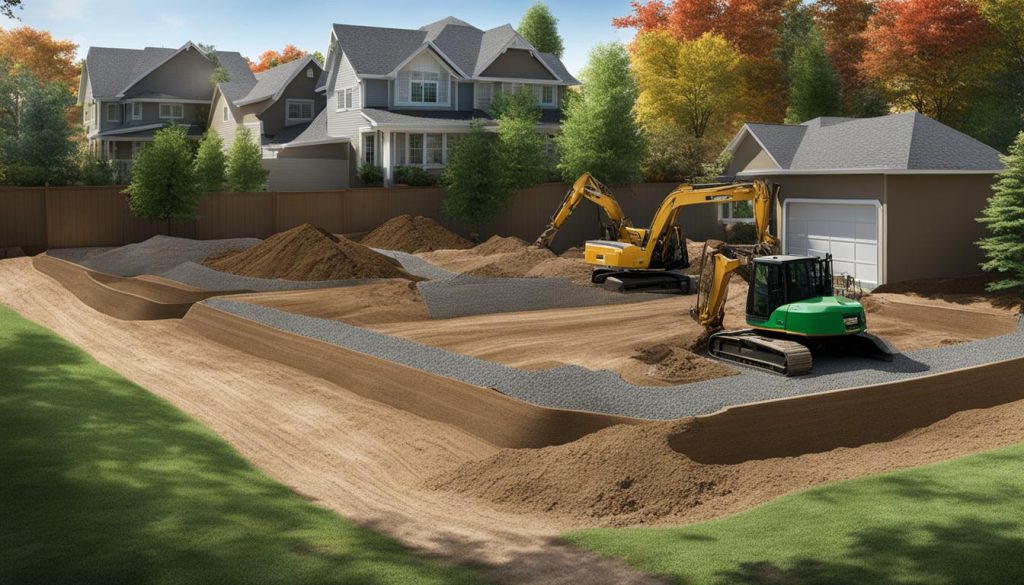
Proper drainage is another essential aspect of site preparation. Without proper drainage, water may accumulate behind the retaining wall, leading to pressure buildup and potential wall failure. Ensure that the site is sloped away from the wall, and install adequate drainage systems, such as gravel or perforated pipes, to prevent water buildup.
By thoroughly preparing the site, you can ensure a solid foundation for your retaining wall, reducing the risk of damage or collapse in the future.
Construction Techniques and Tools
When it comes to retaining wall construction, having the right techniques and tools is essential for a successful project. Here at Retaining Wall Repair, we have years of experience in building and repairing retaining walls, and we’re happy to share our knowledge with you. Below, we’ll outline some of the most important techniques and tools you’ll need to get the job done right.
Excavation Techniques
Before you can begin building your retaining wall, you’ll need to excavate the area where the wall will be built. This involves digging down to a level where the first row of blocks or stones can be laid. It’s important to make sure the area is properly marked out before digging begins, and that you’re aware of any underground utilities or other potential hazards.
When excavating, you’ll want to keep the sides of the trench as straight as possible, to ensure the wall is level and straight. Additionally, you’ll need to make sure the trench is wide enough to accommodate the chosen retaining wall blocks or stones.
Leveling Techniques
Leveling the trench is crucial for ensuring that your retaining wall is structurally sound and visually appealing. There are several techniques you can use to level the area, depending on the size of the project and the tools you have at your disposal.
One common method is to use a string level, which involves stretching a level string between stakes at either end of the trench. This helps ensure that the trench is level from one end to the other.
Another technique is to use a laser level, which projects a straight line of light across the trench to help ensure a level surface. This method is more precise than using a string level, but requires a bit more setup time and equipment.
Backfilling Techniques
Once the retaining wall is built, backfilling is necessary to provide additional support and prevent soil erosion. Before backfilling, it’s important to make sure the area behind the retaining wall is properly graded and that drainage is in place to prevent water buildup.
There are two main types of backfill material that you can use: select fill and backfill soil. Select fill is a high-quality material that is often used in larger retaining wall projects where additional support is required. Backfill soil, on the other hand, is the most commonly used material for smaller projects.
Tools for Retaining Wall Construction
In addition to the techniques outlined above, there are several tools you’ll need to have on hand for successful retaining wall construction. These include:
- A shovel for digging and moving dirt
- A wheelbarrow for transporting materials
- A level for ensuring a level surface
- A masonry saw or chisel for cutting blocks or stones to size
- A hand tamper for compacting soil and backfill
By using these techniques and tools, you can ensure that your retaining wall construction project goes smoothly and results in a structurally sound and visually appealing wall.
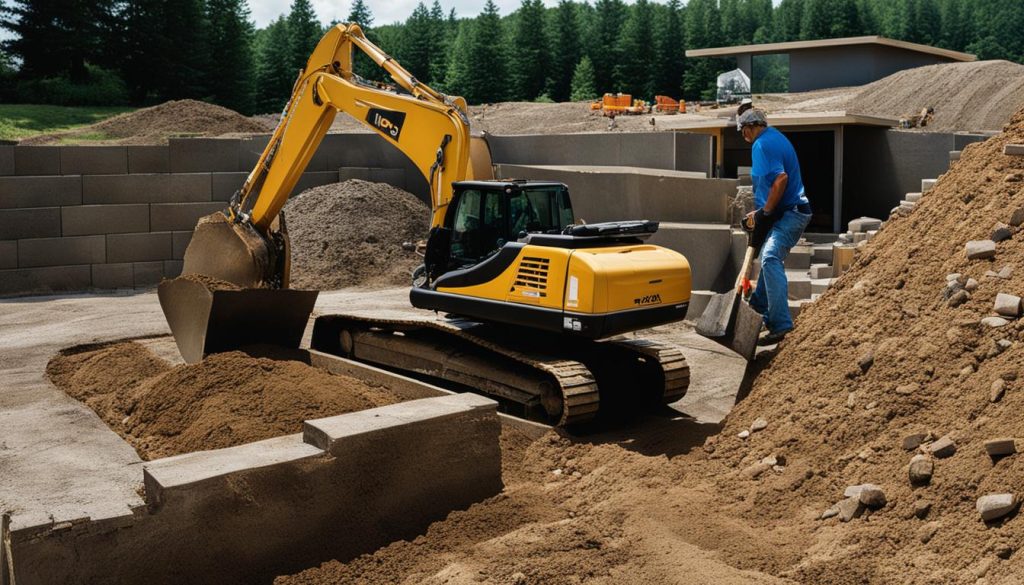
Building the Retaining Wall
Now that we have covered the planning, designing, and material selection, it’s time to start building the retaining wall. This section will guide you through the construction process step-by-step, making it easy to follow and understand. Remember, the safety of yourself and others is crucial, so always follow proper safety measures.
Step 1: Excavation and Clearing
The first step in building a retaining wall is excavation and clearing of the ground where you plan to build your wall. You will need to dig a trench that’s wide enough to fit the retaining wall base and deep enough to provide a sturdy foundation. Make sure to clear the ground of any debris and level it before proceeding to the next step.
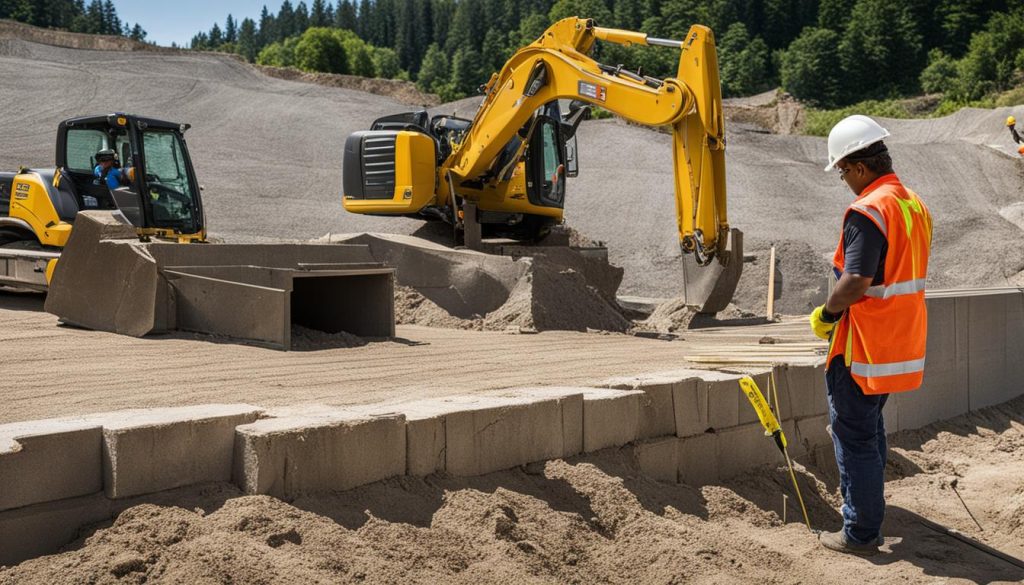
Step 2: Building the Base
Next, it’s time to build the base for your retaining wall, which will provide the foundation for the wall to stand on. This could be made of concrete blocks or poured concrete, depending on your preference. The base should be level and provide structural support for the wall by distributing the weight evenly.
Step 3: Laying the First Course
After the base has been laid and has fully dried, it’s time to start laying the first course of your retaining wall blocks. Make sure to properly align the blocks and use a level to ensure that they’re level and straight. This first course is crucial in ensuring the stability of the entire wall, so take your time and make sure it’s done properly.
Step 4: Continue Laying Courses
Once the first course has been laid, it’s time to continue laying the remaining courses until you reach the desired height. Make sure to stagger the blocks in each course to provide added stability, and backfill each course with gravel and soil for proper drainage. Take the time to check that each course is level before proceeding to the next.
Step 5: Finishing Touches
Finally, once the wall is complete, it’s time to add the finishing touches. You can add a capstone to the top of the wall for added aesthetics, and plants or decorative rocks to enhance the appearance. Remember to also backfill the space behind the wall with gravel and soil to promote proper drainage and prevent water buildup.
Building a retaining wall may seem daunting at first, but with the right tools, materials, and techniques, it can be a relatively straightforward process. Always prioritize safety and take your time to ensure that each step is done properly. If you’re unsure about any aspect of the construction process, don’t hesitate to seek professional assistance.
Finishing and Maintenance
Once you have completed the construction of your retaining wall, it’s important to focus on finishing touches and ongoing maintenance. Proper maintenance practices will prolong the life of your wall and keep it looking great for years to come. Here are some tips on how to finish and maintain your retaining wall:
Finishing Your Retaining Wall
Adding final touches to your retaining wall can enhance its appearance and make it a feature of your property. Consider these options to give your wall a polished look:
- Plant a vertical garden on your wall with climbing plants such as ivy or clematis. This can soften the look of the wall and add natural beauty to your property.
- Create a seating area in front of your retaining wall using outdoor furniture. This can transform your wall into a functional space for relaxation and entertaining.
- Paint the wall to match the aesthetic of your property. This can create a cohesive look and increase curb appeal.
Regardless of the finishing touches you choose, it’s important to maintain a sturdy and structurally sound wall.
Retaining Wall Maintenance
Maintaining your retaining wall is essential for its longevity. Follow these tips to keep your wall in top condition:
- Regularly inspect your wall for any signs of damage or wear and tear. Look for cracks, bulges, or leaning sections and address them promptly.
- Clean your wall regularly to remove dirt and debris that can build up and cause damage. Use a garden hose or pressure washer to wash away the dirt.
- Ensure proper drainage to prevent water buildup behind the wall. This can cause pressure and result in structural damage over time.
- Seal your wall to protect it from the elements. This can prevent water damage and help to extend the life of your wall.
Maintaining your retaining wall may seem daunting, but with the right tools and techniques, it can be done efficiently and effectively. A well-maintained retaining wall can provide long-lasting beauty and value to your property.
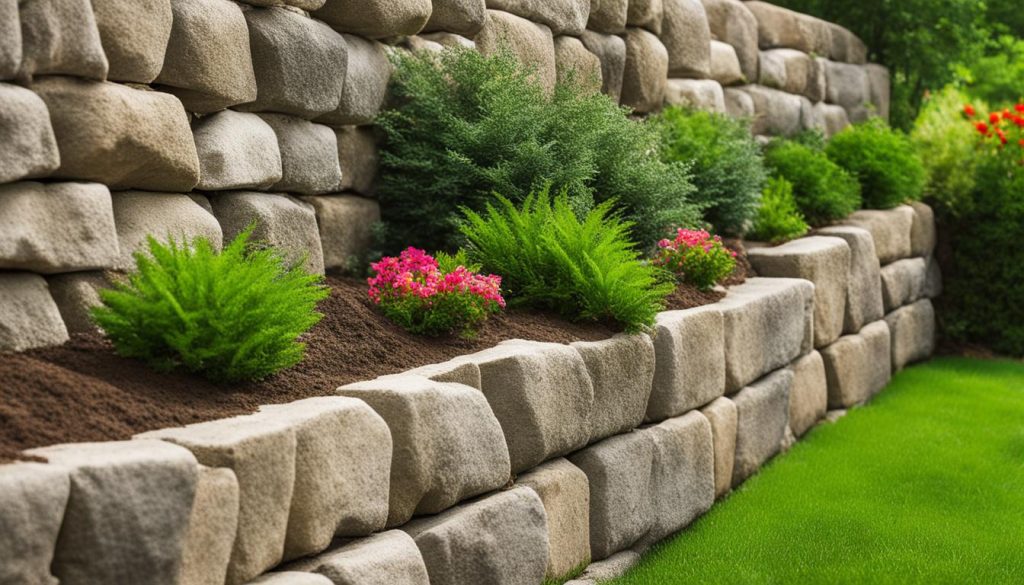
Hiring a Professional Retaining Wall Contractor
If you lack the necessary skills or time to construct your retaining wall, it’s wise to hire a professional retaining wall contractor. Hiring the right contractor can ensure a successful project that meets your expectations and budget.
When looking for a contractor, consider the following factors:
| Factors to Consider | Description |
|---|---|
| Experience | Check the contractor’s experience in building retaining walls. |
| License and Insurance | Ensure the contractor is licensed and insured to operate in your area. |
| References | Ask for references and contact them to get feedback on the contractor’s work. |
| Cost | Compare prices from different contractors and choose one that offers reasonable rates. |
We at Retaining Wall Repair pride ourselves in providing top-notch retaining wall construction services in Canada that meet our clients’ needs. Our team of experienced professionals is well-equipped with the right knowledge and tools to handle any retaining wall project, big or small.
By hiring us, you can expect timely completion, quality workmanship, and impeccable attention to detail. Our services also include retaining wall repair, ensuring that your wall remains in excellent condition for years to come.
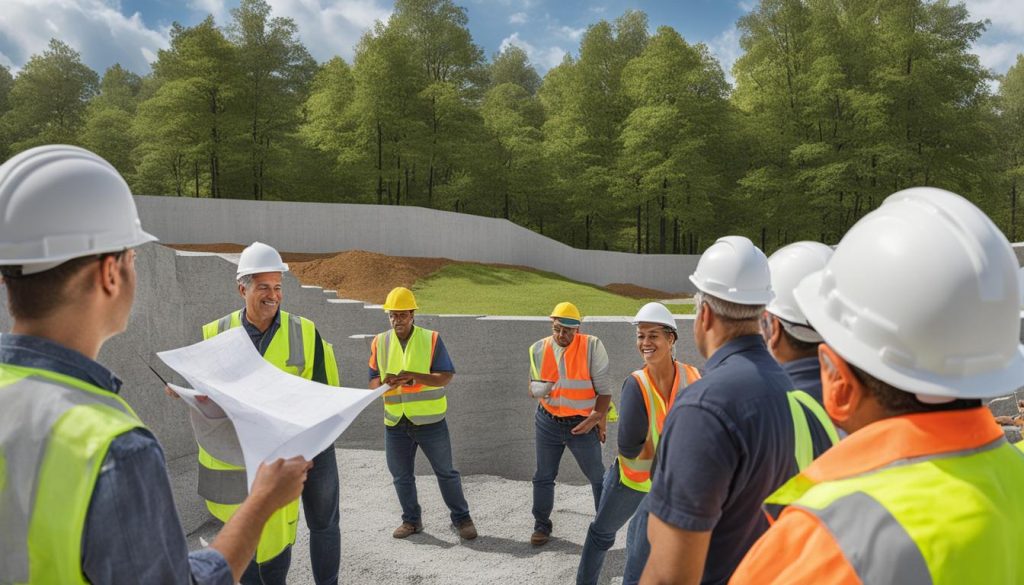
Contact Retaining Wall Repair today at (647) 812-9837 or visit our website at https://www.retainingwallrepair.ca/ to receive a free consultation and learn more about our services. Let us help you bring your retaining wall vision to life!
Legal and Safety Considerations
When it comes to retaining wall construction, legal and safety considerations are essential to ensure a secure and successful project. It’s important to adhere to local laws and regulations to avoid any legal issues in the future. Additionally, safety measures must be in place to protect workers and prevent accidents.
Legal Considerations for Retaining Wall Construction
Before starting your retaining wall construction project, it’s important to obtain any necessary permits and approvals from your local government. Failure to do so can result in fines and legal issues. It’s also important to adhere to building codes and regulations to ensure the safety and stability of the wall.
You may need to consider the following legal requirements:
- Building permit: This permit is required to ensure that your retaining wall meets local building codes and regulations.
- Land use permit: This permit is required if your retaining wall construction project affects the land use of the area.
- Environmental permit: If you are constructing a retaining wall near a water body or on a shoreline, you may need to obtain an environmental permit.
Safety Considerations for Retaining Wall Construction
Retaining wall construction can be dangerous if proper safety measures are not in place. It’s important to prioritize safety to prevent accidents and injuries.
You may need to consider the following safety measures:
- Proper equipment: Workers should have access to appropriate personal protective equipment, such as hard hats, gloves, and safety glasses.
- Safe excavation: Excavation work should be done in a controlled and safe manner to prevent cave-ins and other accidents.
- Proper tool use: Workers should be trained on how to use tools and equipment properly to prevent injuries.
- Stable foundation: The foundation of the retaining wall must be stable and secure to avoid the risk of collapse.
By following legal and safety guidelines, you can ensure a smooth and safe construction process. If you have any questions or concerns about legal or safety considerations for your retaining wall construction project, don’t hesitate to contact us at Retaining Wall Repair. Our team is here to help.
Contact Us for Retaining Wall Construction Services
If you’re in need of professional retaining wall construction services in Canada, look no further than our team at Retaining Wall Repair. Our expert technicians have extensive experience in all aspects of retaining wall construction. We are dedicated to providing superior services to meet your construction needs.
Retaining Wall Repair Services
At Retaining Wall Repair, we offer a comprehensive range of retaining wall construction services, including planning, designing, and building. We can assist you with selecting the right materials for your project and ensuring proper site preparation to achieve a solid foundation for your retaining wall.
Our team of professionals is equipped with the necessary tools and techniques to construct a structurally sound and aesthetically pleasing retaining wall. We will guide you through the construction process, ensuring proper alignment and secure construction, and finish with adding final touches to enhance the appearance of your wall.
In addition to our construction services, we also offer ongoing maintenance to prolong the lifespan of your retaining wall. Our team can address common issues like soil erosion and structural damage, ensuring the continued safety and integrity of your retaining wall.
Contact Us Today
For more information about our retaining wall construction services or to schedule an appointment, give us a call at (647) 812-9837 or visit our website at https://www.retainingwallrepair.ca/. Our team is available to answer your questions and provide assistance for your project. Let us help simplify your retaining wall construction process and ensure successful project completion.
FAQ
What is the purpose of a retaining wall?
Retaining walls are designed to provide support, prevent erosion, and create level surfaces. They are commonly used to stabilize slopes, create terraced landscapes, and protect structures from soil movement.
How do I plan and design a retaining wall?
When planning and designing a retaining wall, important factors to consider include the height and length of the wall, soil conditions, drainage, and any necessary permits. It’s essential to design a structurally sound and visually appealing wall. Consulting with a professional can be beneficial in this process.
What materials can I use for my retaining wall?
There are various materials to choose from when building a retaining wall, including concrete blocks, natural stone, timber, and gabions. Each material has its pros and cons in terms of durability, aesthetics, and cost, so it’s important to consider your specific needs and preferences.
How do I prepare the site for a retaining wall?
Site preparation involves clearing vegetation, leveling the ground, and assessing soil conditions. It’s crucial to ensure proper drainage to prevent water buildup behind the wall, as this can cause structural issues. Adequate site preparation sets the foundation for a successful retaining wall construction.
What construction techniques and tools do I need for a retaining wall?
Retaining wall construction techniques include excavation, leveling, and backfilling. Proper tools, such as shovels, levels, and compactors, are essential for each step of the process. Understanding these techniques and having the right tools on hand will help you complete the construction efficiently.
How do I build a retaining wall?
Building a retaining wall involves laying the foundation, constructing the wall, and securing it properly. It’s important to follow a step-by-step process and ensure proper alignment and structural integrity. Seeking guidance from professionals or referring to detailed instructions can be helpful in this process.
How do I finish and maintain a retaining wall?
After construction, adding finishing touches can enhance the appearance of your retaining wall. These may include applying a sealant or adding decorative elements. Additionally, regular maintenance practices, such as checking for erosion and addressing any structural issues, will help prolong the life of your wall.
Should I hire a professional retaining wall contractor?
While DIY retaining wall construction is possible, hiring a professional contractor can save you time, effort, and minimize potential mistakes. Professionals have the expertise and experience necessary to ensure a successful and long-lasting retaining wall. Consider consulting with a contractor for your project.
What legal and safety considerations are involved in retaining wall construction?
Retaining wall construction involves legal requirements, such as permits and adhering to regulations. It’s essential to understand and comply with these legal considerations to avoid any issues. Safety precautions, such as wearing protective gear and following proper construction techniques, are also crucial to ensure a secure construction process.
How can I contact Retaining Wall Repair for construction services?
If you’re in need of professional retaining wall construction services in Canada, you can reach out to Retaining Wall Repair. Contact us at (647) 812-9837 or visit our website at https://www.retainingwallrepair.ca/ to learn more about our services and how we can assist you with your project.

